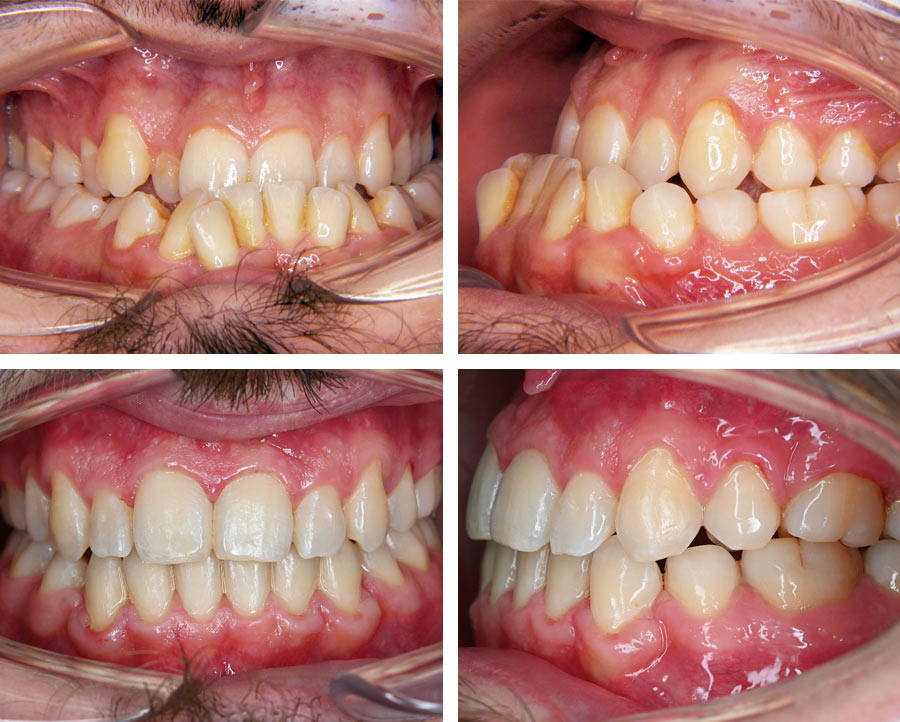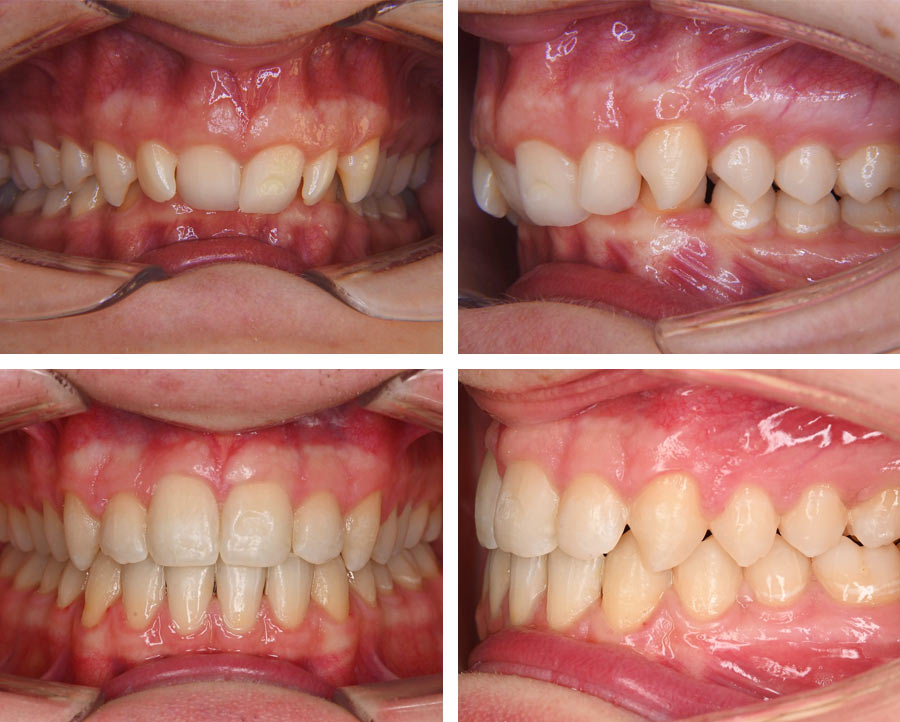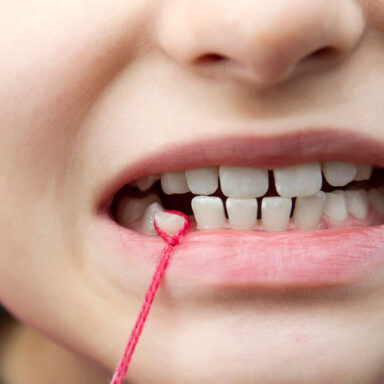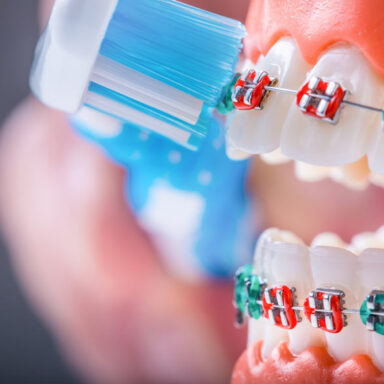Guidebook
Dysgnathia treatment: Jaw surgery for the treatment of pronounced jaw misalignments in adults

People with pronounced misaligned jaws often suffer a great deal. Nevertheless, it is not an easy decision to undergo orthodontic treatment, including jaw surgery, as an adult. Being well informed helps you to find the right way to deal with dysgnathia. In this article, we would therefore like to answer some important questions about orthodontics with dysgnathia surgery.

Author
Dr. Fabian von Rom
Date
Estimated reading time
approx. 8 min
Dysgnathia
Contents
What is dysgnathia?
The term “dysgnathia” refers to a pronounced deviation of the jaws from the norm. This can affect the shape of the jaw, the proportions of the jaws to each other or the spatial relationship of the two jaws to each other.
The video shows the typical phases of dysgnathia treatment using the example of an overbite with a receding chin:
- Initial findings Class II/2 dysgnathia
- After orthodontic pre-treatment with a large overbite
- After corrective osteotomy
How does dysgnathia develop in the first place?
There are many possible causes of jaw misalignments. As a rule, dysgnathia develops during growth. They can be genetically determined or favored by external influences.
The following external influences are possible causes of dysgnathia:
- Trauma (jaw fracture)
- Harmful habits, e.g. excessive thumb sucking or cheek sucking during growth
- malocclusion due to malocclusion (e.g. crossbite or forced bite)
What types of dysgantia are there?
Depending on the spatial direction of the jaw deviation, a distinction is made between different forms of dysgnathia:
- If a jaw is too far back in relation to the opposing jaw, this is referred to as “retrognathia” or a “backbite”. There is then a deviation in the so-called sagittal dimension (front – back direction).
- If a jaw is too far forward in relation to the opposing jaw, this is referred to as “prognathism” or a “forward bite”. Here, too, there is a deviation in the sagittal direction (front – back).
- If the upper jaw is narrower than the lower jaw, there is usually a crossbite. Crossbites occur on one or both sides. It is a deviation in the transversal direction (right – left).
- If the lower jaw deviates to one side, this is referred to as “laterognathia”. There is then also a deviation in the transverse direction (right – left). Latherognathia is often associated with a unilateral crossbite.
- If there is a gap between the upper and lower teeth when the mouth is closed or if not all teeth are in contact, then there is a so-called “open bite” in the “non-contact” area. There is a deviation in the vertical direction (top – bottom). A distinction is made here between frontal open bite, lateral open bite and circular open bite.
All the forms of dysgnathia mentioned can occur in isolation or in combination with each other.
What are the reasons for treating malocclusion or dysgnathia?
Dysgnathia can lead to impaired chewing function and functional overloading of the teeth and jaw joints. This can lead to increased wear of the affected structures as well as pain and discomfort.
An upper jaw that is too narrow can result in restricted nasal breathing. This connection is logical when you consider that the roof of the mouth is also the floor of the nose. A narrow upper jaw therefore results in a narrow airway in the nose.
A malposition of the lower jaw can also have a negative impact on breathing. A so-called mandibular retrognathia, i.e. a backward position of the lower jaw, is often accompanied by a narrowed throat and consequently more difficult breathing and increased snoring. In extreme cases, breathing stops even during sleep. This is known as sleep apnea.
In addition to the functional aspects mentioned, the aesthetic appearance and therefore the well-being of those affected can also be negatively affected by dysgnathia. The main feature of retrognathia of the lower jaw, for example, is a receding chin, while the lower jaw and chin are very dominant in the case of prognathia of the lower jaw.
Laterognathia leads to facial asymmetry.
Dysgnathia surgery often results in a harmonization of facial proportions in addition to the correction of the jaw malposition.
For which jaw misalignments is jaw surgery an option?
Whether dysgnathia surgery and thus combined orthodontic and maxillofacial treatment is advisable or even necessary depends on the severity of the jaw misalignment. In mild to moderate cases, it is possible to treat dysgnathia without surgery and through orthodontic tooth movement alone.
If there is a very pronounced deviation in the jaw that cannot be compensated for at tooth level, or if an explicit and clear change in the profile or facial proportions is desired, a combined orthodontic-jaw surgery approach is used. Here, the orthodontist and the oral and maxillofacial surgeon work hand in hand.
- Jaw surgery for a narrow upper jaw: An upper jaw that is too narrow can be surgically weakened in the area of the bone sutures and then widened orthodontically with the help of special braces (GNE). This procedure is called “surgically assisted palatal expansion”.
- Jaw surgery for a large overbite: If there is a deviation in the front-back direction, the teeth are usually pre-treated orthodontically (straightening, closing gaps between teeth, etc.) before the jaws are surgically moved to the correct position as part of the so-called “repositioning osteotomy”.
- Jaw surgery for a protruding chin: Similar to surgical treatment for a large overbite, the teeth are straightened in the case of a protruding chin before the jaws are surgically repositioned.

How do oral and maxillofacial surgeons and orthodontists work together to treat dysgnathia?
Put simply, it is the task of the oral surgeon to surgically correct the misalignment of the jaw as part of dysgnathia treatment. The task of the orthodontist is to correct the misaligned teeth. As the position of the teeth and jaw strongly influence each other, close coordination between oral and maxillofacial surgery and orthodontics is necessary as part of a dysgnathia treatment.
In combined orthodontic-jaw surgery therapy, 2 procedures are used: the classic procedure or the “surgery first” procedure.
What is the classic course of dysgnathia treatment?
In the classic procedure, the treatment of malocclusion is divided into 3 phases: orthodontic pre-treatment, surgical corrective osteotomy and fine orthodontic adjustment.
- Orthodontic pre-treatment:
The first step is orthodontic pre-treatment. All malocclusions are corrected in this phase. In order to generate an adequate surgical displacement distance for the corrective osteotomy, the malocclusion is first extended in the direction of the existing deviation. This creates the impression of a “worsening” of the dysgnathia in the phase before the operation. This process (decompensation) usually takes about a year and is carried out with fixed external or internal braces.
At the end of orthodontic pre-treatment, the upper and lower dental arches are formed. There are then two harmonious, matching dental arches that do not yet bite together properly due to the malocclusion. - Surgical repositioning osteotomy:
The next step is the so-called surgical repositioning osteotomy. After detailed planning, the jaws are positioned correctly. This is a surgical procedure that is performed by a specialized oral and maxillofacial surgeon. The jaw to be operated on is cut at a defined point as part of the osteotomy. In the upper jaw, this is often done in the so-called Le Fort I plane. In the lower jaw, a so-called sagittal split according to Obwegeser Dal Pont is often performed. This surgical technique has proven successful as it significantly reduces the risk of nerve damage to the mandibular nerve during dysgnathia surgery.
The correct jaw position simulated before surgery is surgically adjusted in the patient’s mouth using the so-called surgical splint. The fixed braces remain in the mouth during the operation and until the end of treatment. An inpatient stay of approx. 2-5 days is usual in connection with dysgnathia surgery. - Fine orthodontic adjustment:
Following the corrective osteotomy, fine orthodontic adjustment is carried out. All necessary corrections are made here to achieve a harmonious end result and a stable bite (e.g. correction of tooth axes, creation of full tooth contacts, etc.). This takes another two to six months before the braces are finally removed.
The advantages of the classic procedure are that the treatment result can be planned very precisely before the operation and a high degree of stability can be expected, as the dental arches usually fit together well immediately after the operation.
How does a dysgnathia operation work according to the surgery-first approach?
In the “surgery-first” procedure, the jaws are surgically repositioned right at the start of dysgnathia treatment. The fixed braces are usually inserted immediately before the jaw surgery. Tooth movement begins immediately after the operation.
The advantage of this serial approach is that the desired profile change occurs directly at the start of treatment. In cases that are suitable for the surgery-first approach, its application often reduces the treatment time required. Whether a patient is suitable for the surgery-first method is assessed and decided on an individual basis.
What is Bimax surgery?
In a repositioning osteotomy, i.e. the surgical repositioning of the jaws, a distinction is made between a mongnath and a bignath procedure. Mongnath means that only one of the two jaws is surgically repositioned. In contrast, both jaws are repositioned in a bimax operation.
This can be useful to reduce the displacement distance of the individual jaw in the case of large discrepancies. A shorter displacement distance has a positive effect on the stability of the result, for example. In the mandible, a reduced displacement distance is also associated with a reduced risk of nerve damage to the sensitive mandibular nerve.
Whether monognathic or bignathic surgery is performed also has an influence on the change in facial proportions and the change in profile. Whether a bimax or monognathic procedure is preferable in individual cases should always be assessed on a case-by-case basis.

Are there alternatives to jaw surgery for dysgnathia?
In some cases, dental compensation is a sensible alternative to surgical jaw repositioning. In this case, the malpositioned jaw is left in place and only concealed by targeted tooth movements. This type of treatment is therefore also known as “camouflage” treatment.
An experienced orthodontist can usually assess which cases are suitable for this option at the first appointment.
Another minimally invasive treatment approach to alleviate symptoms associated with dysgnathia can be splint therapy. This involves leaving the misaligned jaw as well as the malocclusion and misaligned teeth in place. The misaligned bite is compensated for or bridged by the removable splint. Wearing the splint reduces overloading and incorrect loading of the teeth and joint structures.
Conclusion: Various dysgnathia treatment approaches
Depending on the form and extent of dysgnathia, various treatment options are available. Which treatment option is best in each individual case is decided after detailed diagnostics and treatment planning and in close consultation with you as the patient.
We would be happy to advise you individually in our practice in Munich-Unterföhring, which specializes in dysgnathia treatments.
Your expert for orthodontics
Dr. Fabian von Rom
In the specialist practice for orthodontics, Dr. med, dent. Fabian von Rom uses his extensive expertise and many years of experience to offer patients the best possible care. The practice offers the entire spectrum of modern orthodontics and specializes in innovative and advanced treatment methods. In addition to traditional procedures, the focus is on treatment with invisible braces for teenagers and adults – one of the most modern and discreet solutions in orthodontics. Dr. med. dent. Fabian von Rom attaches great importance to ensuring that medical precision goes hand in hand with a high level of patient satisfaction. By equipping the practice exclusively with individual treatment rooms, individual and professional care at the highest level is guaranteed.

Further topics
In our guide you will find lots more information on current, relevant and interesting topics relating to orthodontics. We hope you enjoy reading it!



